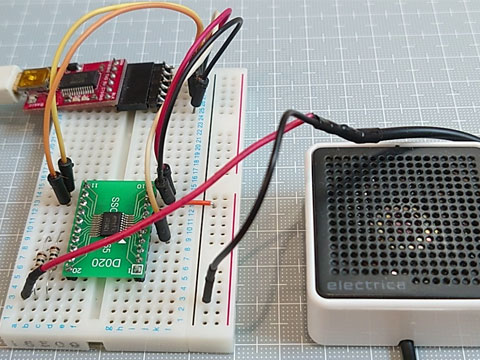RL78/G15 FPB の tone()関数で和音 [Arduino]
RL78/G15 のレジスタを直接いじるの大変そう。PWM作るのにもe2stdioとかいうのを使ってやるみたい。
そこでtone()関数をみてみると、、
RL78G15 20ピン Fast Prototyping Board ピンリスト · renesas_Arduino Wiki · GitHub
https://github.com/renesas/Arduino/wiki/RL78G15-20%E3%83%94%E3%83%B3-Fast-Prototyping-Board-%E3%83%94%E3%83%B3%E3%83%AA%E3%82%B9%E3%83%88
2-7. Tone のところで、Tone output pinに指定できるのは、Arduino 0番, 3番, 13番の3つ。
3つ同時に使えるかと思ったら、3番, 13番を同時に使うのはダメで2和音まででした。

第5オクターブで曲データを作っています。
これより低い音はうまく出せないみたい。
楽譜データの音符などは、notes2.h で。
Digisparkで音楽演奏【楽譜編】
https://hello-world.blog.ss-blog.jp/2022-07-04
そこでtone()関数をみてみると、、
RL78G15 20ピン Fast Prototyping Board ピンリスト · renesas_Arduino Wiki · GitHub
https://github.com/renesas/Arduino/wiki/RL78G15-20%E3%83%94%E3%83%B3-Fast-Prototyping-Board-%E3%83%94%E3%83%B3%E3%83%AA%E3%82%B9%E3%83%88
2-7. Tone のところで、Tone output pinに指定できるのは、Arduino 0番, 3番, 13番の3つ。
3つ同時に使えるかと思ったら、3番, 13番を同時に使うのはダメで2和音まででした。

// RL78/G15 FPB tone function test
#include "notes2.h" // Definition data of notes ( pitch (scale & octave), and note value (length))
#define MAX_TRACK 2 // Maximum number of tracks
const uint8_t ToneOutputPin[] = { 0, 13 }; // two of 0,3,13 pins (No combination of 3 and 13)
const uint16_t F_SCALE[] = { 33488, 35479, 37589, 39824, 42192, 44701, 47359, 50175, 53159, 56320, 59669, 63217 };
// basic frequency of 12-note scale (from C11 to B11)(Hz)
const uint16_t Frogs[] = { // melody data
120 , 0 ,
c5q , d5q , e5q , f5q , e5q , d5q , c5q , RSq , e5q , f5q , g5q , a5q , g5q , f5q , e5q , RSq ,
c5q , RSq , c5q , RSq , c5q , RSq , c5q , RSq , c5e , c5e , d5e , d5e , e5e , e5e , f5e , f5e ,
e5q , d5q , c5q , RSq , RSd , RSd , 0 ,
RSd ,
c5q , d5q , e5q , f5q , e5q , d5q , c5q , RSq , e5q , f5q , g5q , a5q , g5q , f5q , e5q , RSq ,
c5q , RSq , c5q , RSq , c5q , RSq , c5q , RSq , c5e , c5e , d5e , d5e , e5e , e5e , f5e , f5e ,
e5q , d5q , c5q , RSq , RSd , 0 , 0 };
void setup(){
}
void loop(){
const uint16_t *d = Frogs; // Pointer of melody data
const uint16_t *p[MAX_TRACK]; // Pointer for each track of the score
uint8_t Tracks, t; // Number of tracks and counter
uint16_t note; // Note (pitch + note value) information
uint8_t len[MAX_TRACK] = {}; // Length of note (how many 96th notes) (subtraction counter)
uint32_t usInt, usExp; // sound division interval, sound expire time(usec)
usInt = 1000000*60*4 / MIN_NOTE / *d++; // Calculate standard 96th note length(usec) from tempo
for( Tracks=0; Tracks<MAX_TRACK; ) { // Get the number of tracks and the start position of each track from the song data
if( *d++ != 0 ) continue; // Skip until the break comes
if( *d == 0 ) break; // If two zeros follow, end of data
p[ Tracks++ ] = d; // Get location in memory, Count up the number of tracks
}
usExp = micros();
do { // Processing of score for each reference note(96th note) length
for( t=0; t<Tracks; t++) {
if( !len[t]-- ) { // Subtract the length of the note, and when it reaches 0, go to the next note
if( !(note = *p[t]++) ) return; // end if note = 0
len[t] = (note & 0x00ff) - 1; // The lower 8 bits are the length of the note (how many times the length of a 96th note)
if(note & 0xff00) // note(16bit) : Upper 4 bits are octave, next 4 bits are pitch class (0-11)
tone( ToneOutputPin[t], F_SCALE[(note>>8)&0x0f] >> (11-(note>>12)), 0 );
else noTone( ToneOutputPin[t] ); // 0 for rests
}
}
usExp += usInt;
while( micros() < usExp ); // wait until expiration
} while( note );
for( t=0; t<Tracks; t++) noTone( ToneOutputPin[t] ); // stop all sounds
delay(1000);
}
第5オクターブで曲データを作っています。
これより低い音はうまく出せないみたい。
楽譜データの音符などは、notes2.h で。
Digisparkで音楽演奏【楽譜編】
https://hello-world.blog.ss-blog.jp/2022-07-04
タグ:RL78/G15
2023-05-20 17:47
nice!(0)
コメント(0)




コメント 0